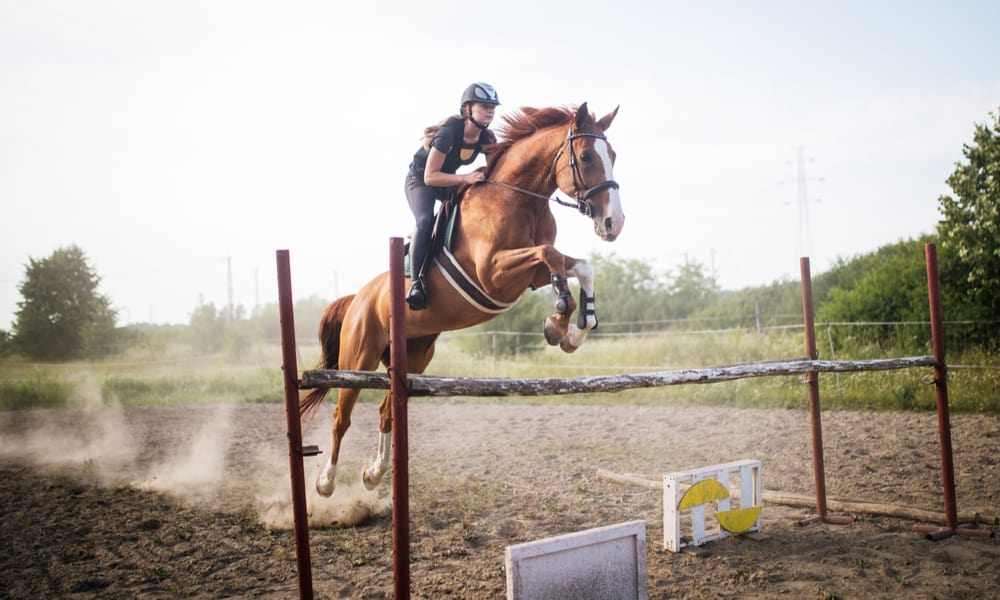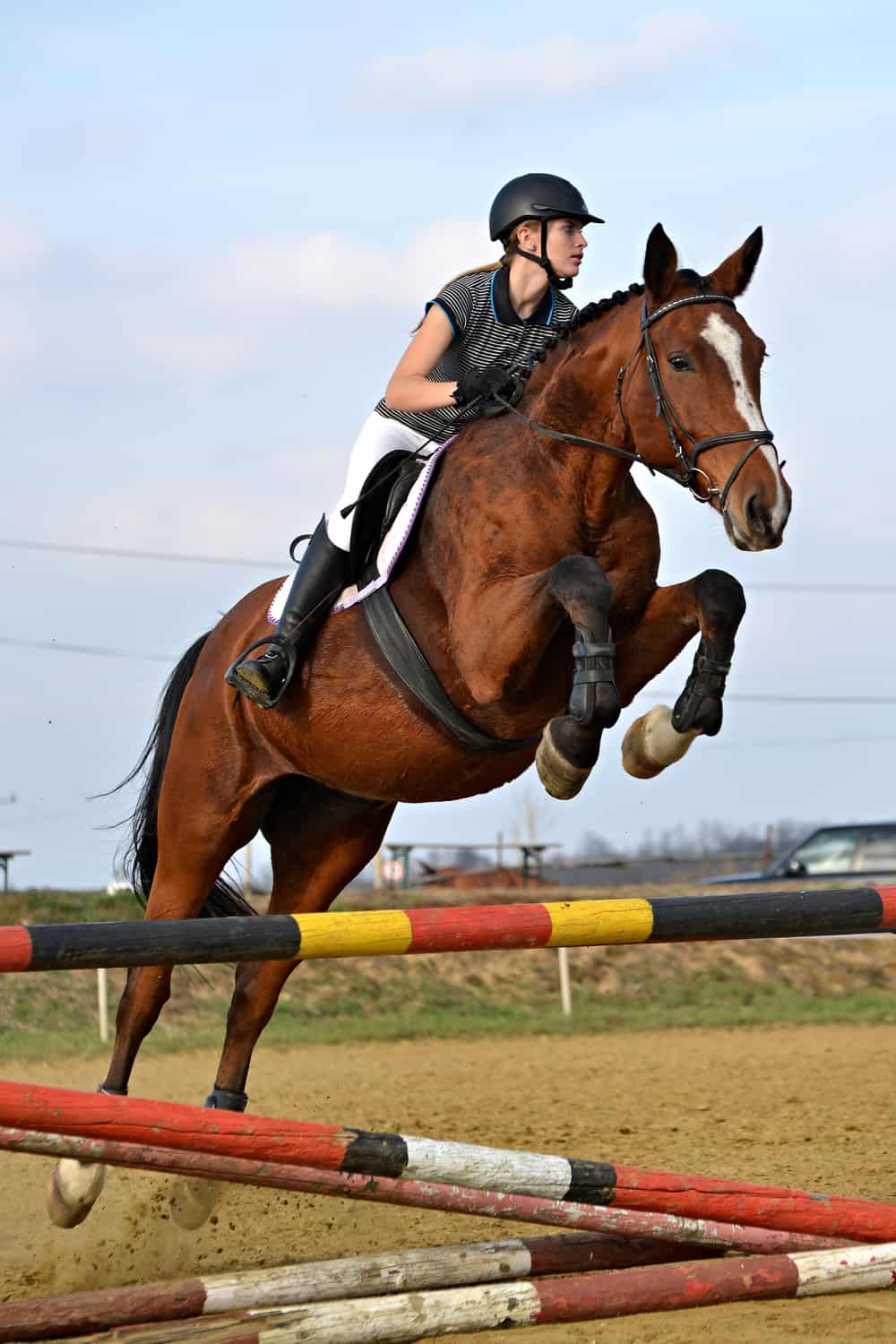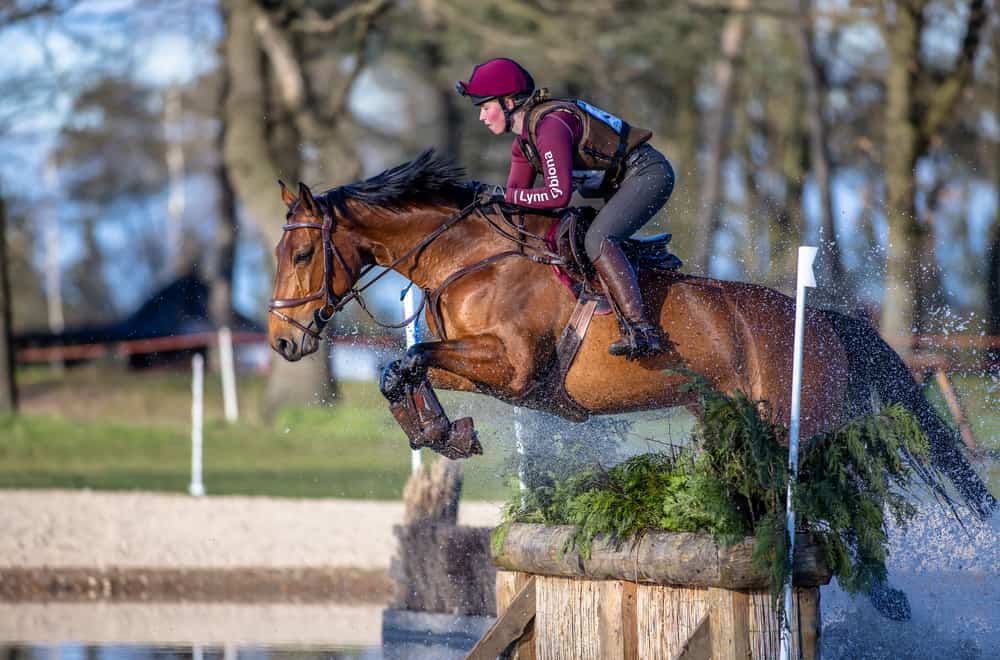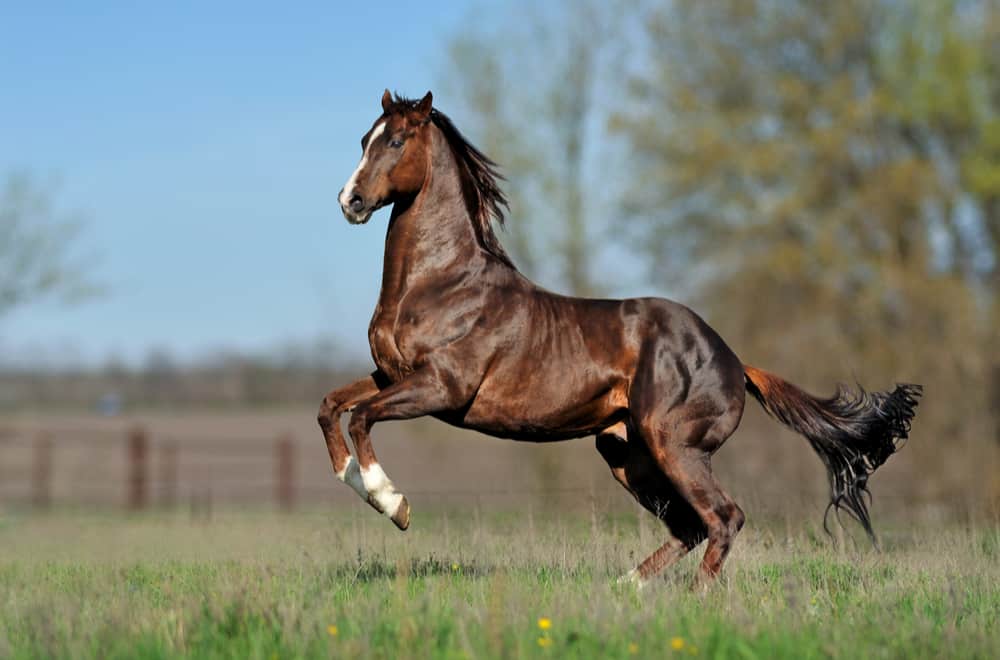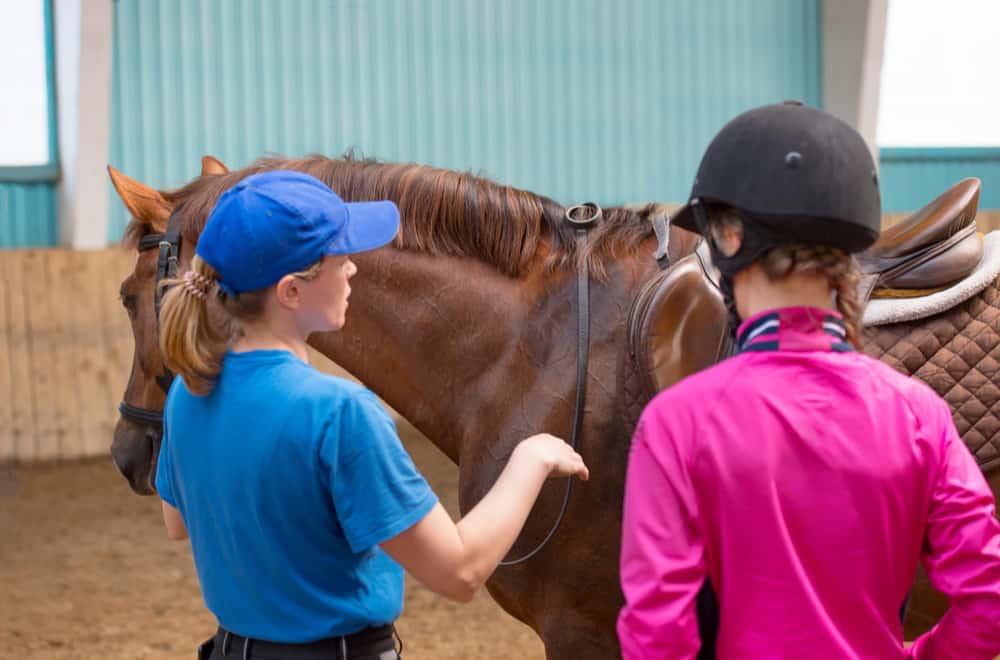Horses are magnificent creatures, and seeing a galloping horse jump over a fence is a sight that rarely leaves anyone indifferent. Still, horse jumping is a superior skill that requires intense training for both rider and animal.
Some horses can jump high effortlessly, especially when reaching for food or are scared. However, others need some extra motivation to go over a small obstacle. How high horses can jump depends on several factors, so let’s discuss them.
Horse Jumping Types
Horses are prey animals that run and jump to escape predators. They can instinctively jump over the fence to run from a source of fear or even grab an apple from a tree.
However, the professional rider’s goal is to train a broken horse to overcome different obstacles. A barrier height depends on the discipline the rider trains the animal for. There are several horse jumping types:
- The high jumping over obstacles of different height levels
- Puissance jumping includes a warm-up fence and a so-called Great wall
- Showjumping is overcoming a wall 3 to 4 feet (0.91 – 1.22 m) tall on average
- Jumping during horse racing
- Steeplechase jumping over low obstacles in high-speed racing
The jump height the horse needs to overcome varies from one discipline to another.
Showjumping |
|
| Level | Obstacle height |
| 0 | 30 to 33 inches (0.77 to 0.85 m) |
| 1 | 33 to 36 inches (0.85 to 0.9 m) |
| 2 | 36 to 39 inches (0.9 to 0.99 m) |
| 3 | 39 to 42 inches (0.99 to 1 m) |
| 4 | 42 to 45 inches (1 to 1.1 m) |
| 5 | 45 to 48 inches (1.1 to 1.2 m) |
| 6 | 48 to 51inches (1.2 to 1.3 m) |
| 7 | 51 to 54 inches (1.3 to 1.37 m) |
| 8 | 54 to 57 inches (1.37 to 1.45 m) |
| 9 | 57 to 60 inches (1.45 to 1.5 m) |
A horse can’t jump from a starting position, so a rider needs to warm up the animal and lead it to a canter or gallop before a jump. Once the horse approaches an obstacle, it will change its gait and move its hind legs under the body.
At the same time, the front legs will extend, and the horse’s withers lower. Each horse jumps differently, but there are typically five phases of jump:
- Approach
- Takeoff
- Bascule (or arc in motion)
- Landing
- Recovery
Factors Affecting Jump Hight
Generally, any horse can jump an obstacle height between 2 and 3 feet (0.6 to 0.9 m). However, several factors will influence how high a particular animal can jump. Let’s see.
Horse measures
The heavier is the horse, the more energy it will need to jump over a high fence properly. In the case of height, the reverse is accurate, and tall horses are easier to spring over high obstacles.
Most trainers recommend training a horse around 16 hands (64 inches / 1.62 m) tall for jumping. However, any pony can skip over a small obstacle under 3 feet (0.9 m), and so do low horses of other breeds.
Horse age
Foals are playful and full of energy, so you won’t have any trouble teaching them to enjoy jumping. However, unbroken animals lack the discipline and patience to overcome obstacles systematically.
Most riders prefer using animals aged 1 to 3 for high jumping and showjumping. Once a horse turns 3 or 4 years, the maximum height of its jumps starts to decline.
Horse breed
The height of a horse’s jump significantly depends on its breed because of the leg length, body shape, temperament, and stamina. Although you can train any horse for jumping with enough effort and time, professional riders prefer one of these breeds:
- Holsteiner
- Hanoverian
- Irish Sport horse
- Thoroughbred
- American Quarter horse
- German Warmblood
- Arabian
- Appaloosa
Many other variables will also affect the jump height, including rider weight and experience, the obstacle type, training, and the discipline the horse competes in.
Average Horse Jump
If you have a farm horse, you should know it can quickly spring over a 3 feet (0.9 m) tall wall and flee from the estate without any trouble. The same goes for wild horses. When necessary, they can jump over 2 to 3 feet (0.6 to 0.9 m) high obstacles.
However, they can also jump much higher under the rush of adrenaline. For instance, an animal in danger will go over a 5 feet (1.5 m) high fence.
Surprisingly, it is not the maximum height your horse can achieve. As I previously mentioned, the maximum jump height depends on several factors, including animal training.
Once your equine is confident in jumping over a 3 feet (0.9 m) high fence, you can raise a bar little by little. You should estimate when to increase the obstacle’s height by a few inches. In time, you can train your horse to jump over 5 or even 6 feet (1.5- 1.8 m) high walls effortlessly.
Famous High Jump Records
According to the Guinness Book of Records, the highest horse jump occurred in 1949. Captain Alberto Larraguibel Morales rode on a horse named Huaso ex-Faithful and jumped an incredible 97 inches (2.47 m) high obstacle.
However, some state sources mention a higher jump in 1927 when Freddy Wettach on a King’s Own horse reached a jump height of 99 inches (2.53 m). Unfortunately, it wasn’t an official horse racing event, so it wasn’t recognized as a record despite witnesses and photos.
Fan fact is that the highest human jump is close to this record. In 1993, Javier Sotomayor leaped 96 inches (2.45 m).
Horse jump records |
|||
| Discipline record | Height | Horse | Year |
| The highest jump | 97.25 inches (2.47 m) | Huaso | 1949 |
| The highest jump (unofficial) | 99 inches (2.53 m) | King’s Own | 1927 |
| The world highest puissance jump | 94.5 inches (2.40 m) | Optiebeurs | 1991 |
| The highest bareback puissance jump | 81.5 inches (2.12 m) | Waterstone | 2011 |
| The highest side saddle jump | 80 inches (2.07 m) | Seic Atlas | 2013 |
| The longest jump | 24 feet (8.4 m) | Something | 1975 |
I want to mention Snowman (Cinderella horse) replaced by a tractor and sent to the slaughterhouse in 1956. Luckily, Harry de Leyer redeemed Snowman and saved it from a terrible fate.
After Harry resold it, Snowman kept coming back to him by jumping over a 5 feet (1.5 m) high fence. The US Equestrian Federation announced it the Horse of the Year in 1958 because of its impressive showjumping career.
High Jump Consequences
Horses with positive stimulation during training can learn to enjoy jumping high, but the jump itself is always a stress for their bodies. Muscles are strained, tendons are stretched, and injury can quickly occur.
An experienced rider can lead a horse to jump over a high obstacle without consequences. However, grooming and quality shoeing are essential in injury prevention.
You should never skip warming up your horse before a jump. It is also necessary to count on the hardness of the ground where you train your animal. That way, you can lower the risk of inflammation, deep bone bruising, sore feet, and suspensory ligament tears.
The training intensity and duration are also something to keep in mind. You can consult professional horse training and make a day-to-day plan your horse benefit from.
If you overwork your equine and force it beyond its limits, it will cause permanent injuries or even death due to a broken leg or spine.
Never forget that horses in the wild rarely jump for pure pleasure. Jumping is necessary for a horse to run from predators or reach for food. In nature, it is always aimed at survival.
Therefore, daily showjumping horse training is always stressful for the animal. It will need plenty of rest, supplements due to more intense calorie consumption, and regular veterinary checkups.
Even with all of the above, the cartilage wears out, tendons weaken, and muscle and bone degenerate over time. In other words, a horse’s jumping career is never long-lasting.
Tips for Horse Jump Training
If you are not a skillful rider, you should take care not to ride over extremely high fences even when you have a well-trained horse. There are several things to remember before jumping:
- Never look down but straight over the obstacle to prevent disturbing your horse balance
- Shorten your stirrups slightly before high jumping
- The animal can feel your fear, so don’t panic
- If you are not confident in yourself, your horse can easily refuse to jump and stop, resulting in your fall
- If you jump the same fence repeatedly, you should try to aim for the middle of the obstacle. Then, turn alternately left and right after the jump to prevent the horse from getting bored
- Never punish the horse if it refuses to jump over the fence. A better option is to lead it to trot a small circle around the obstacle and try again.
Summary
An average untrained horse can jump as high as 2 to 3 feet (0.6 to 0.9 m). Still, you can train your animal to jump much higher, depending on its fitness, breed, age, and obstacle type.
Your riding skills have a significant influence on jump height, as well. Since a horse risks permanent injures when jumping, you should be careful when training and competing.
